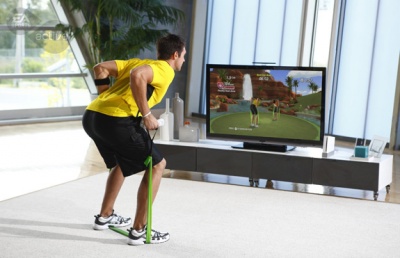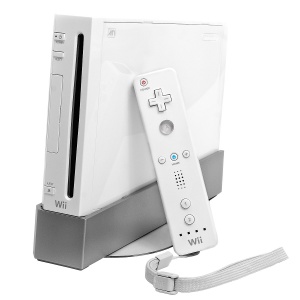Difference between revisions of "Fitness Game"
(→Dance Dance Revolution) |
(→Dance Dance Revolution) |
||
| Line 17: | Line 17: | ||
[[File:FitnessGame3.jpg|300px|thumb|right|Two men playing Dance Dance Revolution on the dancing stage.]] | [[File:FitnessGame3.jpg|300px|thumb|right|Two men playing Dance Dance Revolution on the dancing stage.]] | ||
'''Dance Dance Revolution (DDR)''' was produced by a Japanese entertainment and gaming company called Konami in 1998. DDR is a music video game series that pioneered the rhythmic dancing game market. To play, players stand on a ''dance platform'' and step on the colored arrows according to the visual cues which follow along to the rhythm of a song. Once the round is finished, players are judged by how well they timed their "dance" steps. Players earn a higher score if they accurately connected with visual cues with the rhythm. The winning player has the option to continue to the next round and play again. | '''Dance Dance Revolution (DDR)''' was produced by a Japanese entertainment and gaming company called Konami in 1998. DDR is a music video game series that pioneered the rhythmic dancing game market. To play, players stand on a ''dance platform'' and step on the colored arrows according to the visual cues which follow along to the rhythm of a song. Once the round is finished, players are judged by how well they timed their "dance" steps. Players earn a higher score if they accurately connected with visual cues with the rhythm. The winning player has the option to continue to the next round and play again. | ||
| − | ''Dance Dance Revolution'' has been given much critical acclaim for its originality and longevity in the video game market. There have been numerous arcade-based launches across 20 countries and hundreds of home video game console releases. In these arcades, dancers often have dance battles against one another to see who can earn the highest score on the game. Dance Dance Revolution is considered a home and arcade game because of the versatile environment the | + | ''Dance Dance Revolution'' has been given much critical acclaim for its originality and longevity in the video game market. There have been numerous arcade-based launches across 20 countries and hundreds of home video game console releases. In these arcades, dancers often have dance battles against one another to see who can earn the highest score on the game. Dance Dance Revolution is considered a home and arcade game because of the versatile environment the game can be placed in. It is a game that can be enjoyed by just one person or ten people. From the 20 years that it has been an active and popular game console,''Dance Dance Revolution'' has promoted a music library of original songs produced by Konami's artists and a set of licensed music from many different genres while prompting inspiration for similar musical games. |
==After the 21st century== | ==After the 21st century== | ||
Revision as of 05:05, 28 March 2018
Fitness Game is a term that refers to the type of online video game that specifically demands players to execute physical exercise as a part of the gameplay. Although companies like Nintendo and Konami have introduced the concept of fitness game in the 1980's-1990's, the cost for the supporting technology was expensive and its technological capability was still behind in fully grabbing consumers' attention. Nonetheless, the introduction of motion control by Nintendo's Wii and Microsoft's Xbox enhanced both the features and the efficiency of fitness game. As a result, the field of fitness game became more attention-grabbing and more consumers became willing to get the benefit of exercising by playing fitness game.
Contents
Current Examples
Some well-known examples of the motion control fitness game include Wii Sports Club[1], Just Dance[2], and Nike+ Kinect Training[3]. Also, the launch of wearable like Fitbit[4] and Apple Watch[5] initiated many developments to the fitness game industry due to wearable's feature of tracking heartbeat; one of the examples of fitness game that utilizes wearables would be Exantra World[6]. Nintendo Wii allows players to actively engage in the video game by physically doing the motion of hitting a tennis ball with a tennis racket or swinging a golf club to hit a shot, along with other motions [7]. Many of these motions, including others, activates the user's muscles in the game to incorporate a physical component to a traditionally stationary game. Similar gaming consoles incorporate traditional games that users play without the physical component to recreate their experience while offering the same excitement and fun of user's favorite video games.
Before the 21st century
Because the overall development of fitness game mostly relies on technology, the field of fitness game was still in its beginning stage before the 21st century. Yet, there were a couple products that introduced the idea and the potential success behind fitness game.
Life Fitness Exertainment Systems
The Life Fitness Exertainment System is an exercise bike made by Life Fitness (a manufacturer of exercise equipment) in collaboration with Nintendo. It was released in the US in the 1990's and offered compatibility with the Super Nintendo console. Designed to allow the player to exercise while playing video games, Life Fitness Exertainment System shows similarity with Wii Fit, only the system was produced over a decade earlier. A few games were designed to be used with the Exertainment bike, like Speed Racer in My Most Dangerous Adventures[8] and Exertainment Mountain Bike Rally[9]. Although the idea behind this product was straightforward, there were multiple problems that arose and ultimately marked the failure of this project. The first problem was the cost of the system. That the model itself was significantly more expensive than a typical exercise bike. There were also additional costs of the electronics to institute the gaming features. The high production costs made it inefficient for mass production. There were also problems with production quality. The model was not durable and broke easily. The issue of durability is one of the most significant problem for any fitness equipment to have and thus gave this model a negative reputation on the market. Lastly, users often found operating the gaming software intimidating. The software lacked instructions on how to use the product , and users felt uncomfortable having to employ software knowledge in order to exercise.
Dance Dance Revolution
Dance Dance Revolution (DDR) was produced by a Japanese entertainment and gaming company called Konami in 1998. DDR is a music video game series that pioneered the rhythmic dancing game market. To play, players stand on a dance platform and step on the colored arrows according to the visual cues which follow along to the rhythm of a song. Once the round is finished, players are judged by how well they timed their "dance" steps. Players earn a higher score if they accurately connected with visual cues with the rhythm. The winning player has the option to continue to the next round and play again. Dance Dance Revolution has been given much critical acclaim for its originality and longevity in the video game market. There have been numerous arcade-based launches across 20 countries and hundreds of home video game console releases. In these arcades, dancers often have dance battles against one another to see who can earn the highest score on the game. Dance Dance Revolution is considered a home and arcade game because of the versatile environment the game can be placed in. It is a game that can be enjoyed by just one person or ten people. From the 20 years that it has been an active and popular game console,Dance Dance Revolution has promoted a music library of original songs produced by Konami's artists and a set of licensed music from many different genres while prompting inspiration for similar musical games.
After the 21st century
Beginning in the 21st century, especially during 2010s, the field of fitness games made a dramatic development because of considerable technological advancements that occurred simultaneously. These technological developments, including motion control and wearable technology, became a major part of the newest fitness games.
Nintendo's Wii
Released in November 2012 by Nintendo[10], the Wii U is the first eighth-generation video game console presented in the video game market[11]. The Wii U is also the first video game console to introduce the concept of motion control, a technological capability to accurately depict player's physical motion and encrypt such motion into the gaming interface. This feature greatly enhanced the accuracy of fitness games because it can track the exact motion a player makes, thus creating a more interactive gaming interface for the players while tracking exercise. Below is the list of Wii games that utilize motion control.
| Name of the game | Released Year | Exercise Type |
|---|---|---|
| Wii Fit | 2007 | Interactive Mini Games |
| Wii Fit Plus | 2009 | Interactive Mini Games |
| Wii Fit U | 2013 | Interactive Mini Games |
| Wii Sports | 2006 | Sports-based Game |
| Just Dance 2016,2017,2018 | 2016, 2017, 2018 | Rhythmical Dance Game |
| Wii Street U | 2013 | Augmented Reality |
| Your Shape: Fitness Evolved 2013 | 2013 | Virtual Training Game |
| Zumba Fitness World Party | 2013 | Rhythmical Dance Game |
Smartphone, Wearables, and Exantra World
Wearable has given a significant influence to the field of fitness games. Unlike other gaming consoles/equipments, smartphones and other wearable technologies show a great portability and great technological features, thus allowing users to have a more efficient exercise while experiencing high-end technological gaming interfaces. Although there are numerous fitness apps that utilize both smartphones and wearable technology, there never has been a fitness game that incorporated both technologies.
Exantra World is the first Online Role-Playing fitness app (iOS) that allows players to build their own avatar, known as a Titan. The app prompts users to strengthen their Titans by statistically increasing their abilities with virtual points. Once their Titans get strong enough, users can compete with other Titans. What makes Exantra World technologically is its simultaneous utilization of wearable technology and a smartphone. When the user begins to exercise, wearable technologies measure the increase in the user's heart rate and analyzes the heat-rate intensity. The technology then sends the heart rate data to the game and the game converts the data into virtual points. The user can later spend their virtual points to develop his or her own Titan and play the game.
Ethical Concerns
One of the greatest concerns facing fitness games is health information privacy and how user information is used. As wearables are actively playing a role in fitness games, many aspects the games have changed, largely due to the ease of collecting and sharing user health data.
Health Information and its utilization
Initially, the users played fitness games during late 1990s and throughout the 2000s did not have an issue with the sharing their health information nor with how their information was used. However, sharing and using user's health information became the major ethical dilemma of the fitness gaming industry and as video-game companies began incorporating modern technology to their fitness game developments. For example, in case of Exantra World, players are continuously exposed to the game interface and the wearable technology while he or she is playing the game. Once the wearable have accumulated enough health information about the player, the wearable will then transmit that information to the smartphone device and convert the player's health information into a virtual points. This illustrates the circumstance in which player's health information could be exposed to the entire gaming interface and therefore is not secure. Possible consequences of this would be publicizing one's health information, which is very private data.
Credibility of Generalized Workout
This issue fundamentally questions the efficiency of many fitness games on the market. In real life, a personal trainer has the personal trainer certification, like American Council on Exercise (ACE)[12] or National Academy of Sports Medicine (NASM)[13] to certify that he or she is a credible resource for efficient exercises that are personally suited to the client. This is not the case in fitness games. There is no certification that gives credibility to the type of exercise that the player can do via fitness game. There is no guarantee that the type of exercises that a player can do through the fitness game is going to be beneficial or safe given the player's physical condition. Since there is not trainer physically present, it is up to the wearable technology to determine at what point a workout is no longer beneficial, but harmful to a player. Unfortunately, programs are not yet sophisticated enough to explain their logic behind the specific workouts they recommend to everyday users. Wearable health programs are thinking like humans, but cannot explain these decisions to their users which can cause serious injuries. [14]
Technological Bias
As both old and new fitness games continue to enhance their popularity, there are many uncertainties in the ethical standards with which these games are being constructed. Particularly, as Alison Adams describes, "we should not necessarily expect new technologies to be free of old patterns of behavior and prejudices.>ref>Adam, Alison. Cambridge Handbook, Chapter 9, “Personal values and computer ethics.” </ref> Adam's touches on many issues arising within their field. First, there is still a large portion of these technologies which is coded by humans. Humans have biases. Additionally as mentioned before, the people that are creating these algorithms are not necessarily trained to be creating these workouts. Similarly, those who create the technology can be targeting certain groups, particularly women, with unrealistic body expectations which are evident in proportionally harder workouts. These are some of the many unknowns in fitness gaming.
References
- ↑ "Nintendo Website" https://www.nintendo.com/games/detail/23dwBGv7QCFrP08BKcqDpsq-6hxvaaTB
- ↑ "Just Dance Ubisoft Website"https://just-dance.ubisoft.com/en-us/home/
- ↑ "Nike+ Kinect Training Demo https://www.youtube.com/watch?v=CoM_MNZ5pzU
- ↑ "Fitbit Website"https://www.fitbit.com/home
- ↑ "Apple Watch Website"https://www.apple.com/apple-watch-series-3/?afid=p238%7Cs2QbmM6cp-dc_mtid_1870765e38482_pcrid_224100368864_&cid=aos-us-kwgo-watch--slid--product-
- ↑ "Exantra World Website"https://www.exantraworld.com/
- ↑ "Nintendo Website" https://www.nintendo.com/games/detail/23dwBGv7QCFrP08BKcqDpsq-6hxvaaTB
- ↑ "Nintendo Wikia of Speed Racer in My Most Dangerous Adventures"http://nintendo.wikia.com/wiki/Speed_Racer_in_My_Most_Dangerous_Adventures
- ↑ "Nintendo Wikia of Exertainment Mountain Bike Rally"http://nintendo.wikia.com/wiki/Exertainment_Mountain_Bike_Rally
- ↑ "Wii U Confirmed Release Date"http://metro.co.uk/2012/01/26/wii-u-confirmed-for-europe-this-year-297126/
- ↑ "Article about eighth-generation console"http://www.businessinsider.com/nintendos-project-cafe-will-gamers-feel-the-buzz-2011-5
- ↑ "ACE Website"https://www.acefitness.org/fitness-certifications/personal-trainer-certification/default.aspx?utm_campaign=Banner_Ads&utm_content=PT_Career_Guide_160x600#personal-trainer-marketing-download&utm_source=Rakuten&utm_medium=4&ranMID=42334&ranEAID=nuU3r0LI7IY&ranSiteID=nuU3r0LI7IY-z4ahl3I7Oi5OJxyKDUbk1g
- ↑ "NASM Website"https://www.nasm.org/become-a-personal-trainer?utm_source=cj&utm_medium=affiliate&utm_campaign=Bolt+Fitness&utm_content=7356170
- ↑ Doshi-Velez, Finale and Mason Kortz. "AI is more powerful than ever. How do we hold it accountable?" 20 March 2018, https://www.washingtonpost.com/outlook/ai-is-more-powerful-than-ever-how-do-we-hold-it-accountable/2018/03/20/e867b98a-2705-11e8-bc72-077aa4dab9ef_story.html?utm_term=.0048934e43e1. Accessed 26 March 2018.




